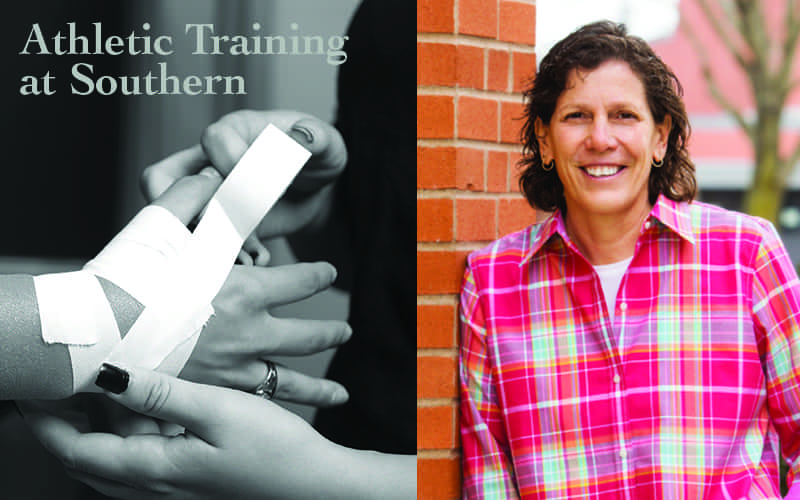Recognizing Sharon Misasi’s Contributions During National Athletic Training Month
by Dr. Gary Morin, chair, Health and Movement Sciences Department; and Diane Nowak, secretary, Health and Movement Sciences Department
As we celebrate athletic training at Southern during this National Athletic Training Month, we would like to recognize Dr. Sharon Misasi and our program advancements under her leadership.
Dr. Misasi is currently a professor in Southern’s Department of Health and Movement Sciences. She returned to her alma mater in 1988 to propel the athletic training program into what was then called a National Athletic Trainers Association (NATA) Approved Program. Prior to that date, Southern’s program was considered an internship program but there was an interest in moving toward an accredited program. “Back then there were two routes to become an athletic trainer: an internship program or a NATA Approved Program. We were going from internship to NATA Approval,” remarked Misasi.
At the time, athletic training was still a relatively new profession for women, and the selection of Misasi as the program director was somewhat unique. “There were not many women program directors or Athletic Trainers. My certification number is 497 after becoming certified in 1984.” Misasi elaborated, “In fact, back then Southern still had separate women’s and men’s physical education programs.”
At the time, female athletic trainers were looked at differently. “My journey was interesting as job interviews are often done by athletic directors and coaches who were men. They would include questions about why I wanted to work with male athletes and go into the locker rooms. They didn’t ‘see’ women athletic trainers as medical professionals,” furthered Misasi. “I would educate them and stand firm stating I was a medical professional and treated all athletes regardless of gender identity.”
Misasi and her colleagues, including then Head Athletic Trainer Linda Holbrook, worked tirelessly through the Women’s Physical Education Department to get the courses approved through the process, becoming the first in Connecticut to gain NATA approval in 1990. Since gaining that first NATA approval, the Athletic Training Education Program went through many changes to become the prestigious program it is today.
The divided women’s and men’s departments merged in 1990 and later became the Exercise Science Department. A little over two years ago, with the addition of the Health Science and Respiratory Therapy degree programs, it was renamed the Department of Health and Movement Sciences. The Athletic Training program became accredited first through the Commission on Accreditation of Allied Health Education Programs (CAAHEP) and later Commission on Accreditation of Athletic Training Education (CAATE), and just recently, the program became a master’s degree program offering admission through a traditional master’s degree or through an accelerated BS/MAT offering.
As far as gender equality is concerned, athletic training has changed greatly. After being a distinct minority among the profession, women now make up the majority of members in the National Athletic Trainer’s Association and have attained many of the national professional leadership positions. “Some of our female graduates have made a definite mark in our program either in the form of student leadership positions in the Eastern Athletic Trainers’ Association such as Meaghan Kelley and Dolci Wagner who became the leaders of the EATA’s Student Leadership. Others have gone on to very successful careers such as Janet Simon who is on the faculty at Ohio University and Hannah Berg who is on the staff at Boston College,” according to Dr. Gary Morin, the department chairperson of Health and Movement Sciences and former athletic training program director.


